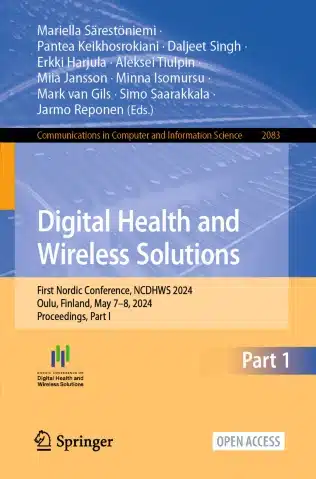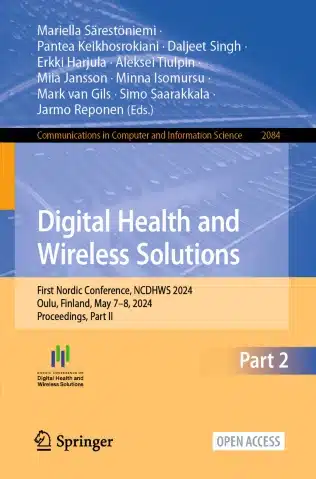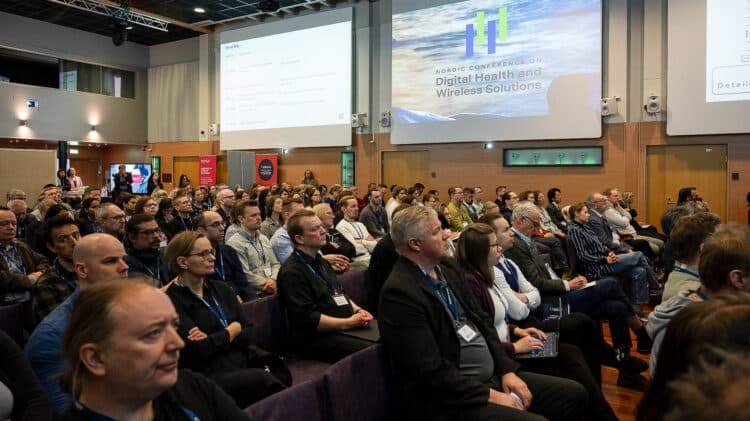
Pioneering Digital Health at the Nordic Conference on Digital Health and Wireless Solutions
The Nordic Conference on Digital Health and Wireless Solutions brought together a community of passionate researchers and healthcare professionals in the scenic setting of the Hotel Lasaretti in Oulu, Finland. Organised by the University of Oulu’s 6GESS and DigiHealth research programmes from May 7-8, 2024, the conference created a vibrant space for exploring the latest advancements in digital healthcare and wireless communications. Attendees eagerly anticipated insightful discussions, collaborative efforts, and a glimpse into the future, where cutting-edge research paves the way for transformative innovations in healthcare delivery.
The conference commenced with Professor Jarmo Reponen, the Conference President, welcoming attendees and highlighting Oulu’s celebrated strides in healthcare innovation. He traced the evolution of Oulu’s digital health technologies from their nascent stages in the 1990s to their current significant role. His account highlighted how digital infrastructure has become the foundation for Finland’s innovative healthcare solutions, exemplified by the Finnish national health service reforms seamlessly integrating digital transformation to transform service delivery.
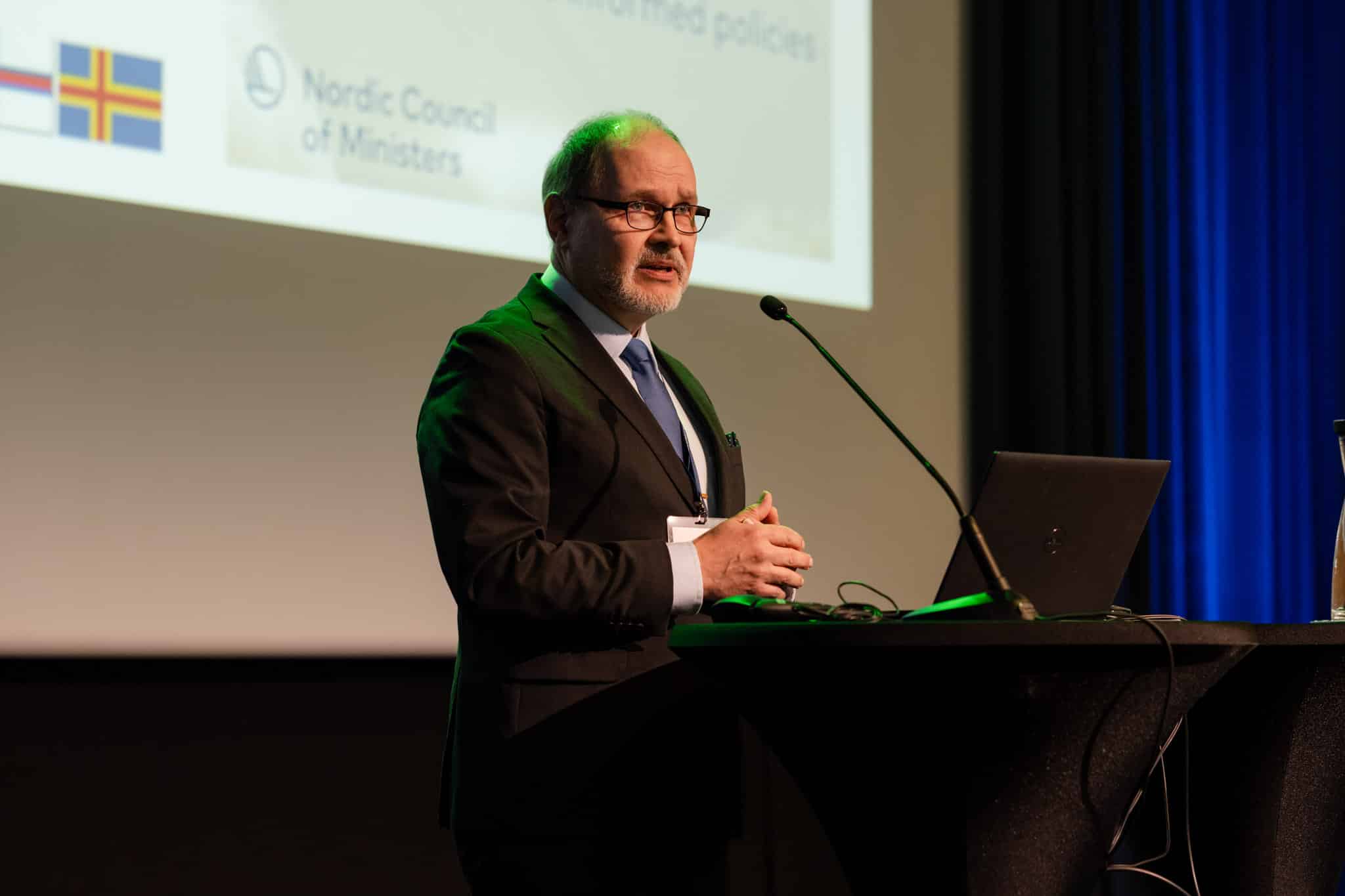
Professor Jarmo Reponen, President of the Nordic Conference on Digital Health and Wireless Solutions, welcomed a large audience of interested professionals, researchers, and industry leaders at the premier event in Oulu, Finland. The conference, organized by the 6GESS and DigiHealth research programmes from the University of Oulu, is a key platform for discussing the latest advancements in digital health and wireless communications.
Professor Reponen highlighted the cutting-edge projects currently underway at the University of Oulu, giving a particular focus on the 6G Flagship research programme. He described 6G Flagship as a pioneering initiative exploring the potential of 6G technology that goes beyond the current boundaries of 5G technology. Among other research directions, 6G Flagship develops intelligent, highly efficient services tailored specifically for healthcare applications. Such initiatives exemplify Oulu’s commitment to remaining at the forefront of digital and wireless healthcare technologies, supported by robust collaborations between academia and healthcare institutions like the Oulu University Hospital.
Global Perspectives on Health Innovations
Kaisa Juuso, Finnish Minister of Social Affairs and Health, sent a special video greeting to the conference. She outlined the Finnish government’s strategic initiatives that aim to strengthen Finland’s knowledge-rich, secure, and economically robust society by providing enhanced digital health services.
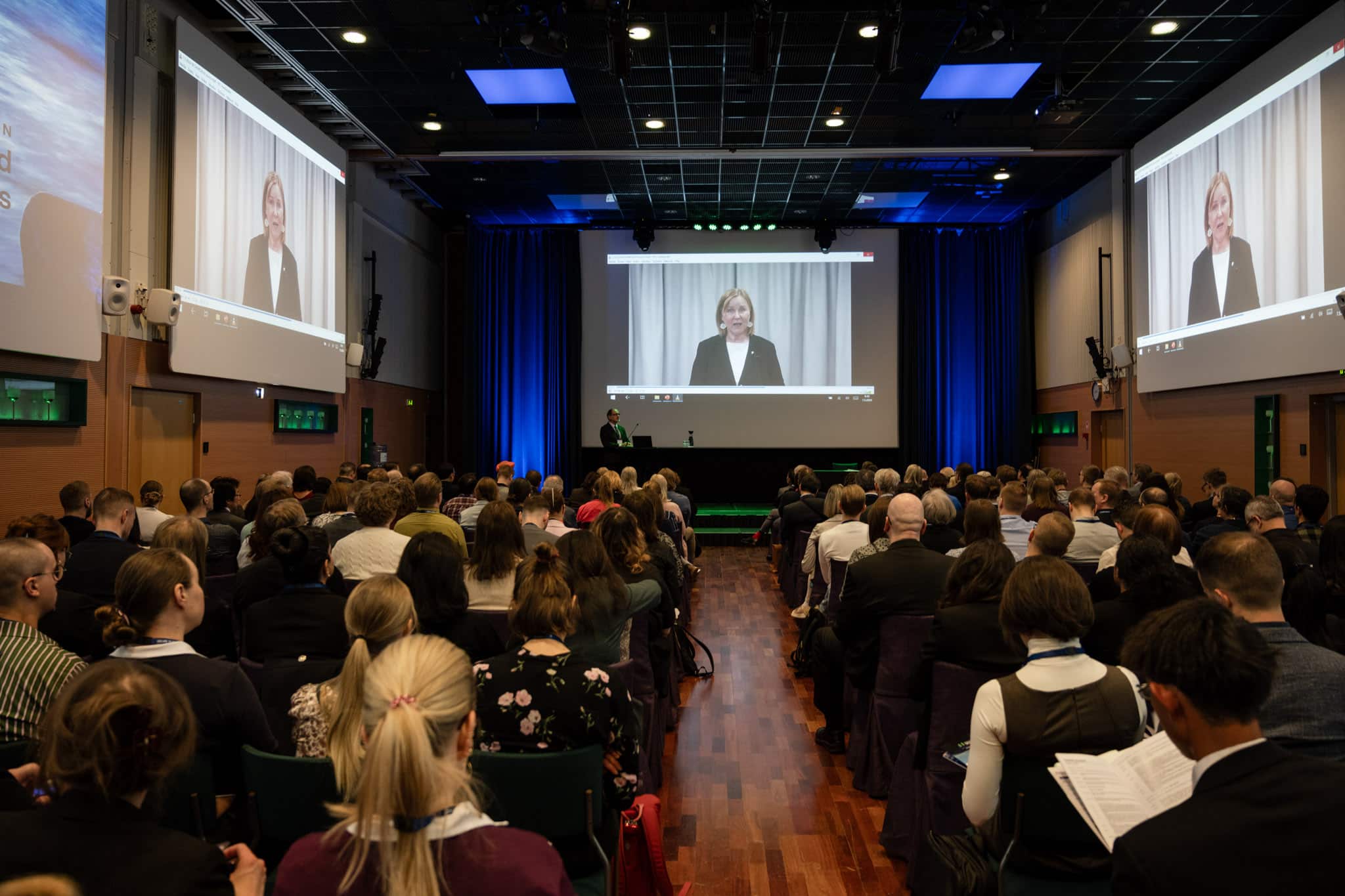
“The digital transformation plays a key role in reforming our health and social services,” says Finnish Minister of Social Affairs and Health Kaisa Juuso, addressing the event audience in her video greeting.
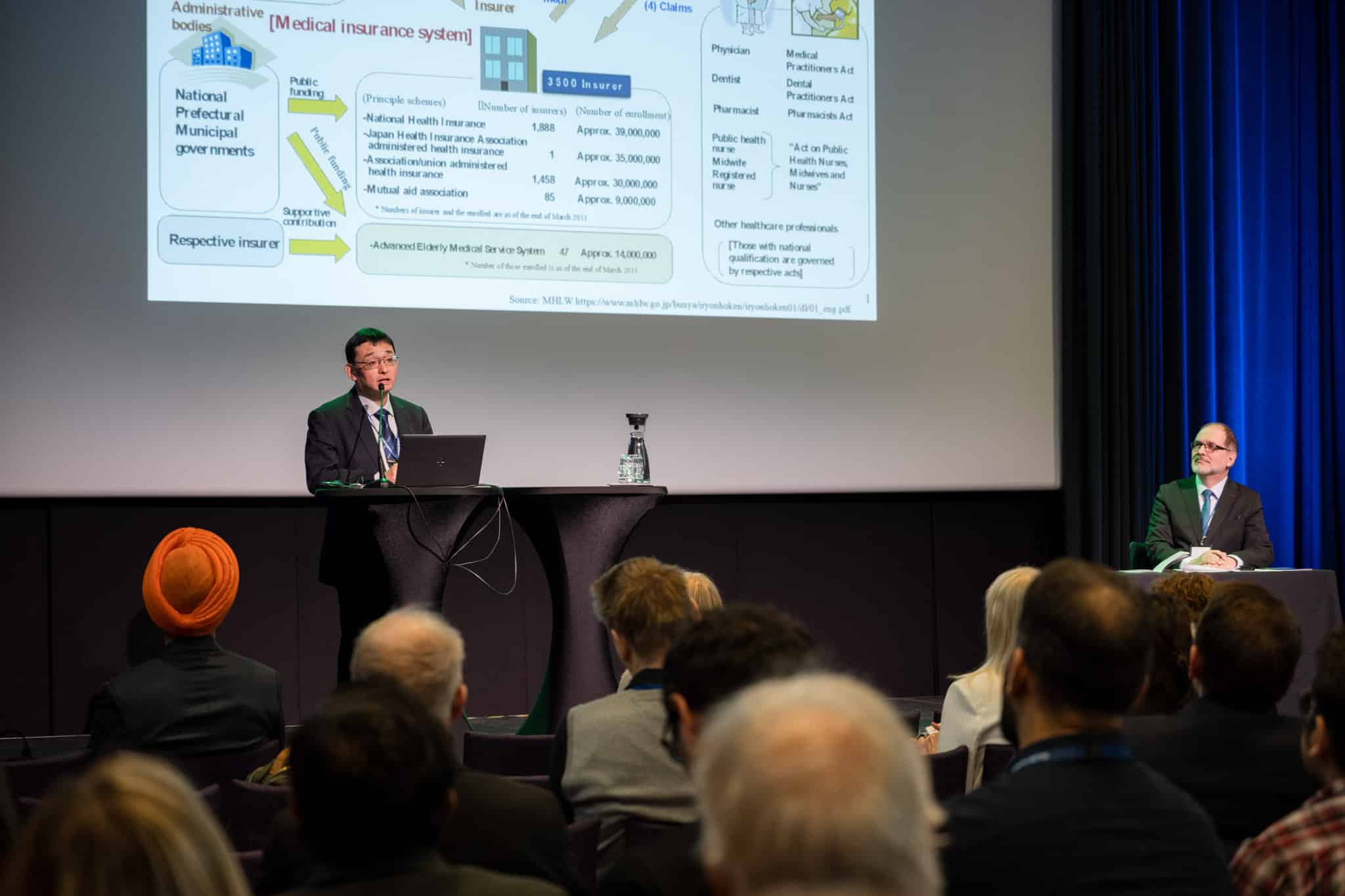
“Our vision for future medical healthcare technology involves significant integration of AI in computer systems,” says Professor Tomohiro Kuroda the Director of Division of Medical Information Technology and Administrative Planning of Kyoto University Hospital.
Professor Tomohiro Kuroda from Kyoto University, Japan, set the stage with the first keynote address. He provided a comprehensive overview of Japan’s digital health strategy and discussed the intricacies and multiple challenges of integrating a unified electronic health record system nationwide. Professor Kuroda’s insightful presentation offered the audience a global perspective on the complexities involved in advancing digital health initiatives. His candid discussion of the hurdles faced in Japan shed light on the persistent obstacles nations around the world must overcome to realise the full potential of digitised healthcare systems. The audience gained invaluable insights into the intricate interplay between technological advances, regulatory frameworks and the seamless integration of digital solutions into existing healthcare infrastructures.
Harnessing AI to Transform Radiology Workflows and Clinical Decision-Making
Freiburg University’s Professor Elmar Kotter’s invited speech focused on integrating AI in radiology to combat the increasing complexity and volume of medical imaging data. He highlighted a significant shortfall in the number of radiologists, a problem exacerbated by a ‘data tsunami’ that overwhelms existing personnel with up to 70,000 images daily. Kotter illustrated how AI could assist in managing this deluge, mainly through enhanced image acquisition techniques. He provided examples of how AI can streamline processes, such as MRI Deep Learning reconstruction, which reduces scan times while improving image quality, and AI-enhanced CT scans that deliver higher-resolution images faster. This reduces the time required for radiologists to review images and enhances workflow.
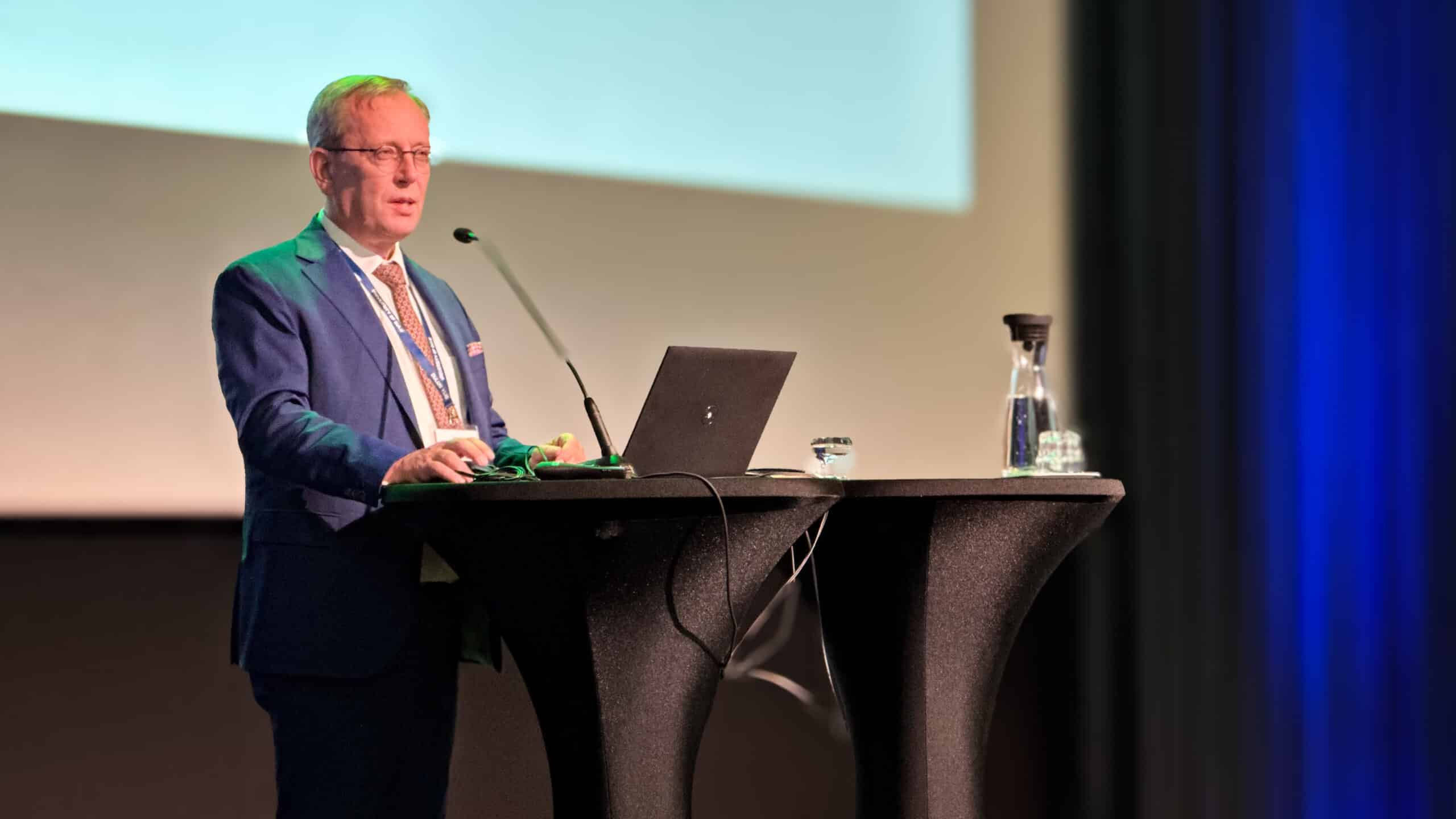
“We face a radiologist shortfall and a data tsunami with up to 70,000 images daily. AI can help manage this by enhancing image acquisition, reducing scan times, and improving image quality, streamlining workflows,” said Professor Elmar Kotter, the Head of Imaging Informatics in the Department of Radiology at Freiburg University Medical Center in Germany.
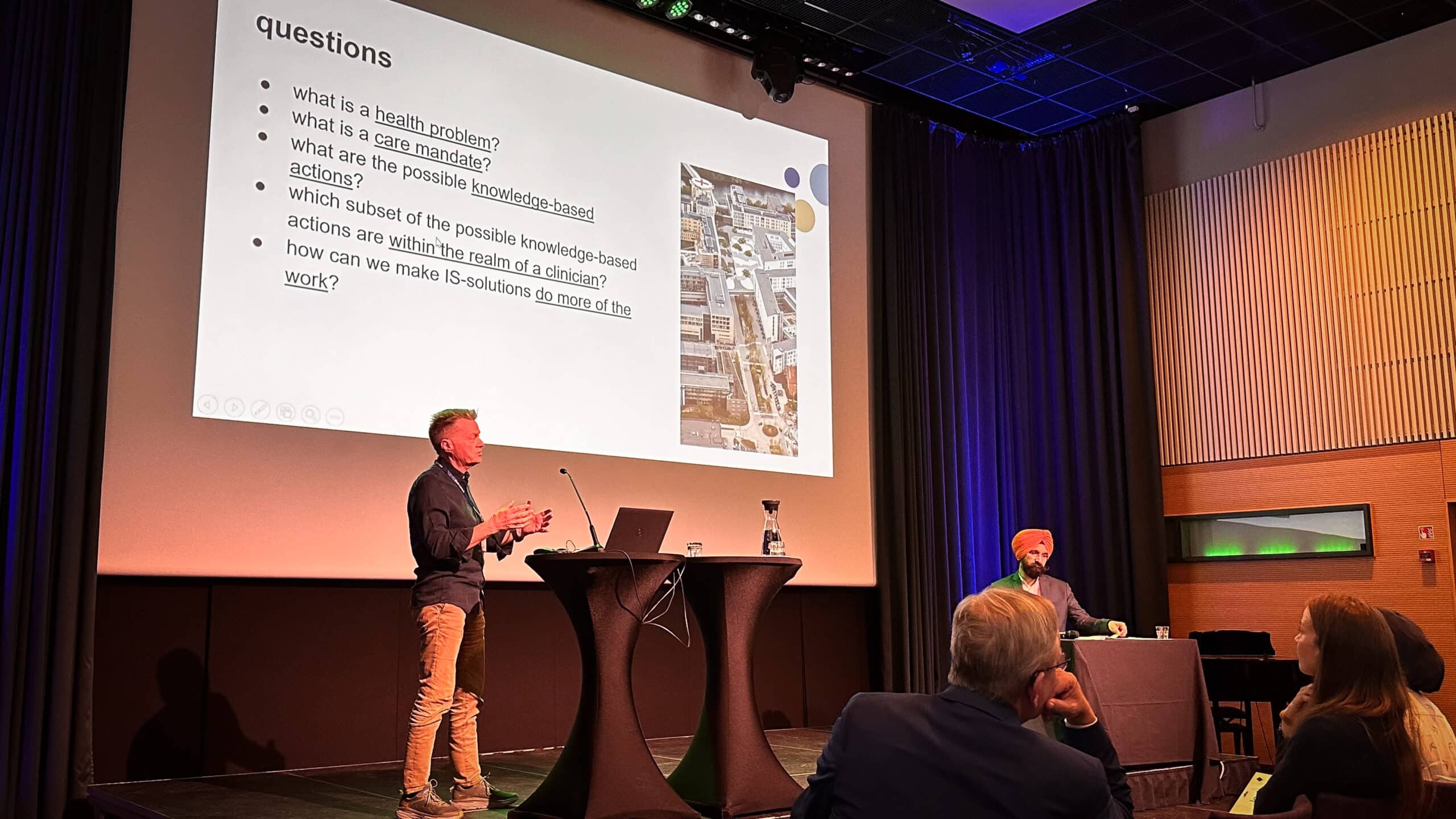
Professor Arild Faxvaag from the Norwegian University of Science and Technology discussed how AI can streamline routine medical tasks, improve diagnostic accuracy, and augment clinicians’ capabilities rather than replace them.
Professor Arild Faxvaag, from NTNU, in his invited speech, discussed the potential of IT solutions to enhance knowledge-based care, focusing on the symbiotic relationship between AI and clinical decision-making. He discussed how AI can streamline routine medical tasks, such as automated bone age and leg axis measurements, into quick, reliable processes. He also discussed the broader implications of AI in synthesising patient data, which could significantly enhance diagnostic accuracy and treatment planning. Faxvaag presented a compelling vision where AI does not replace clinicians but rather augments their capabilities, allowing them to focus more on patient care than administrative tasks, potentially transforming the landscape of healthcare provision.
AI Transforms Musculoskeletal Diagnostics and Care
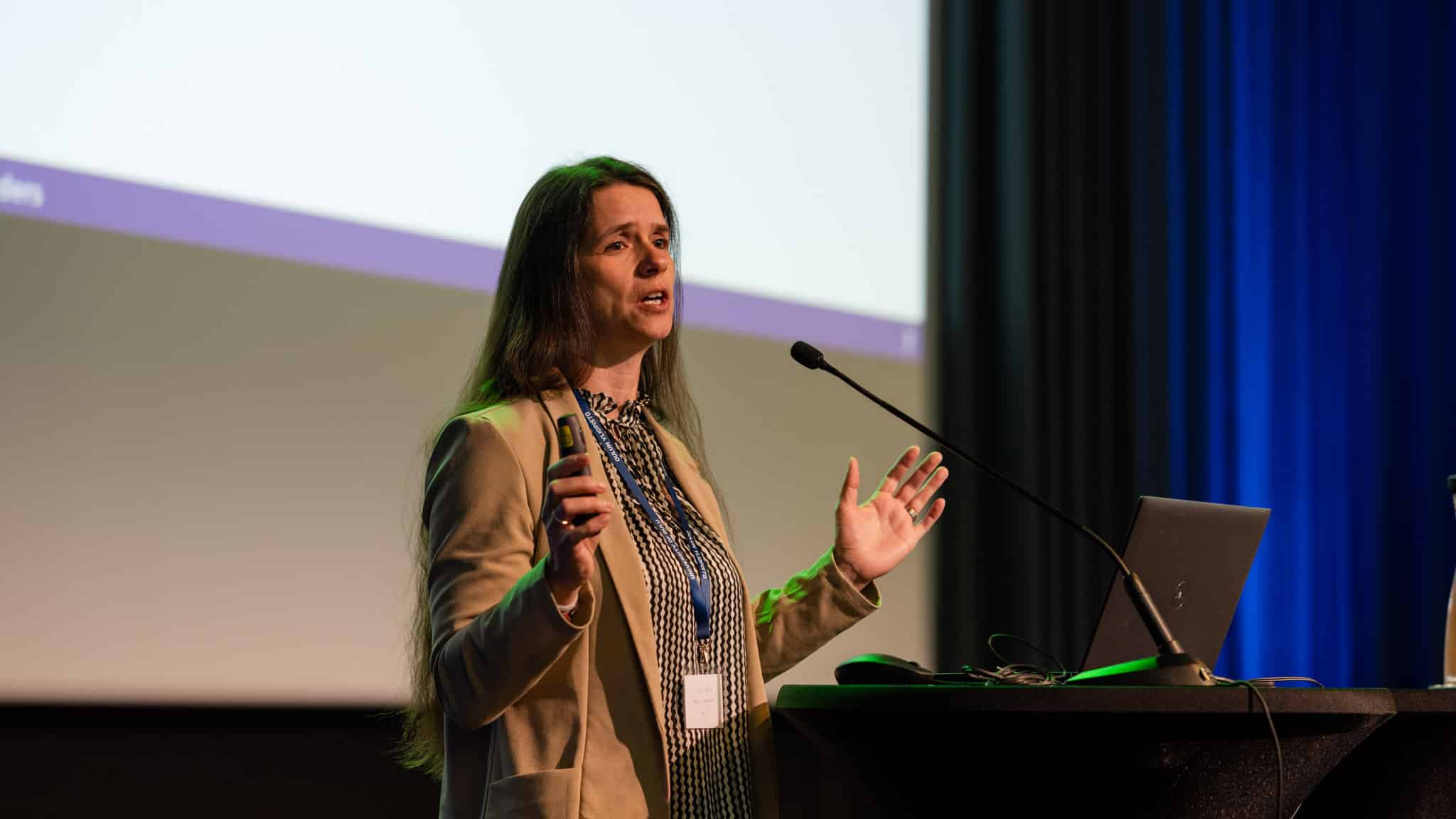
“We use AI-based technologies, like BoneFinder, to extract meaningful information from medical images, helping diagnose and treat musculoskeletal disorders such as osteoarthritis and osteoporosis,” shared Dr Claudia Lindner, Sir Henry Dale Fellow and Senior Research Fellow in the Division of Informatics, Imaging & Data Sciences at the University of Manchester.
In a compelling session on AI-Based Medical Image Analysis in Musculoskeletal Disorders, Dr Claudia Lindner from the University of Manchester, UK, presented cutting-edge technologies transforming the diagnosis and management of musculoskeletal conditions. Musculoskeletal disorders, which affect an astonishing 1.71 billion people worldwide and are a leading cause of disability, are now being more precisely evaluated thanks to AI innovations like BoneFinder® technology. This AI-driven tool is adept at identifying and delineating fundamental structures in medical images, such as the proximal femur in hip bones. The software tool enhances both the accuracy and efficiency of medical diagnostics.
Dr Lindner discussed the technology’s machine learning framework, which involves a training stage that helps the system learn the specificities of the anatomical structures it needs to identify in new images. This technology locates the points and understands their expected positions and relationships in various images, allowing for sophisticated analyses and interpretations in clinical settings. Such capabilities are essential for tailoring patient care and improving treatment outcomes in conditions such as osteoarthritis and osteoporosis, where precise imaging can significantly influence management strategies.
The technology’s potential applications are numerous. For instance, it enables the automated generation of geometric measurements vital for assessing disease progression and planning treatments. Dr Lindner presented studies where AI-assisted measurements corresponded closely with those taken manually by clinical experts, demonstrating the system’s reliability and accuracy. As AI continues to evolve, its integration into clinical practices promises to enhance diagnostic and treatment precision and revolutionise how healthcare providers manage and monitor musculoskeletal disorders. This will ultimately lead to better patient outcomes and more efficient use of healthcare resources.
Addressing the Global Digital Health Divide
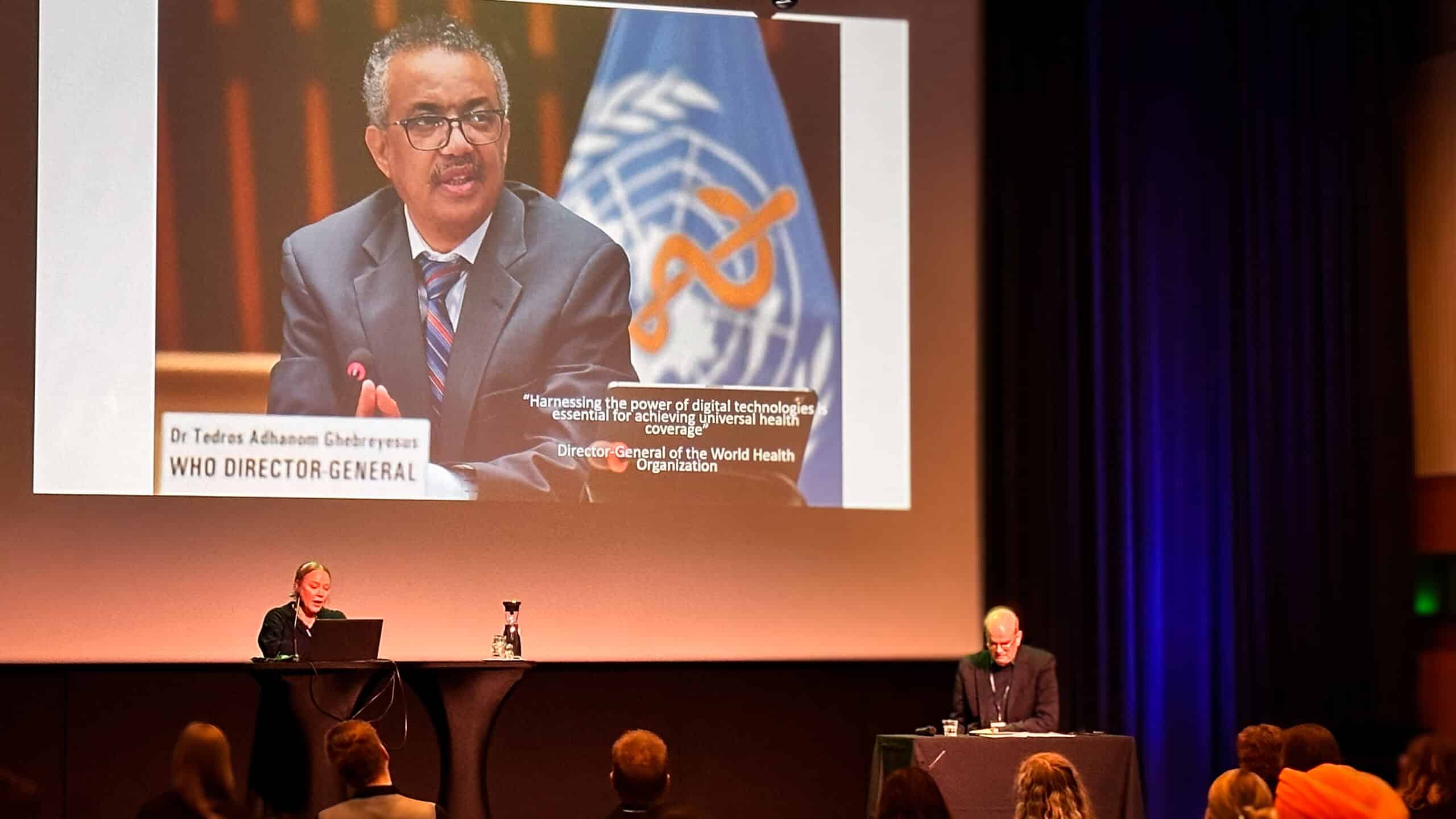
“Harnessing the power of digital technologies is essential to achieving universal health coverage. Most of the world’s population does not have access to basic health services. We are not going to achieve universal health coverage without digital health,” said Katri Kontio, Regional Advisor in Health Information and Digital Health at WHO.
As the digital age surges with technological advancements like 6G, a stark digital divide is becoming globally increasingly evident. Nearly 3 billion people lack primary digital access, a disparity that Katri Kontio, Regional Advisor in Health Information and Digital Health at WHO, emphasised during a key session at the conference. Ms Kontio highlighted the challenges low- and middle-income countries face in adopting digital health technologies, which are crucial for achieving universal health coverage, a core Sustainable Development Goal (SDG).
Ms Kontio’s analysis covered the evolution of digital health over the past two decades, noting critical milestones like the WHO’s first e-health resolution in 2005 and the 2020 launch of a global digital health strategy. Despite these advancements, she highlighted the significant gap between policy intentions and implementation in developing countries, where limited digital infrastructure and inadequate policy frameworks hinder effective digital transformation. She also shared success stories, such as telemedicine programmes that have effectively bridged healthcare gaps during the COVID-19 pandemic, demonstrating the potential for digital health solutions to transform care delivery.
The journey toward closing the digital health divide is complex and fraught with technological, financial, and educational barriers. Kontio highlighted the issue of digital silos, which arise when digital and paper-based systems are used in parallel. These silos disrupt data flows and reduce efficiency. She emphasised the need for a global strategy that enhances interoperability, adopts open-source solutions and strengthens international collaboration to prepare health systems for future challenges and ensure that digital health benefits reach all corners of the globe.
Oulu’s Rising Star in Digital Health and Cultural Innovation
At the event’s gala dinner, Professor Jarmo Reponen, the Conference President, delivered a heartfelt speech that captured Oulu’s pioneering spirit. “Their zeal for technological progress was so insatiable that they procured one of the earliest X-ray imaging devices even before the city had an operational electricity power plant to run it,” Reponen recounted, delighting the audience with this vivid illustration of the city’s unwavering commitment to innovation. He inspired attendees to foster multidisciplinary collaborations among academia, industry, and end-users, emphasising the importance of working together to drive technological advancement.
Saija Hyvönen, Deputy Chair of the Oulu City Council, welcomed event participants to Oulu, Finland’s fifth-largest city. She highlighted Oulu’s unique position as a hub for digital health and wireless communication technologies, attributing its success to the University of Oulu’s collaborative research across disciplines like medicine and engineering, the Nokia legacy that fostered consumer-focused product design skills now applied in health tech, and the Oulu Health Ecosystem’s collaborative network driving innovation. Hyvönen invited attendees to experience Oulu’s innovative spirit and cultural offerings.
On-Site Visits: Future Hospital and Beyond
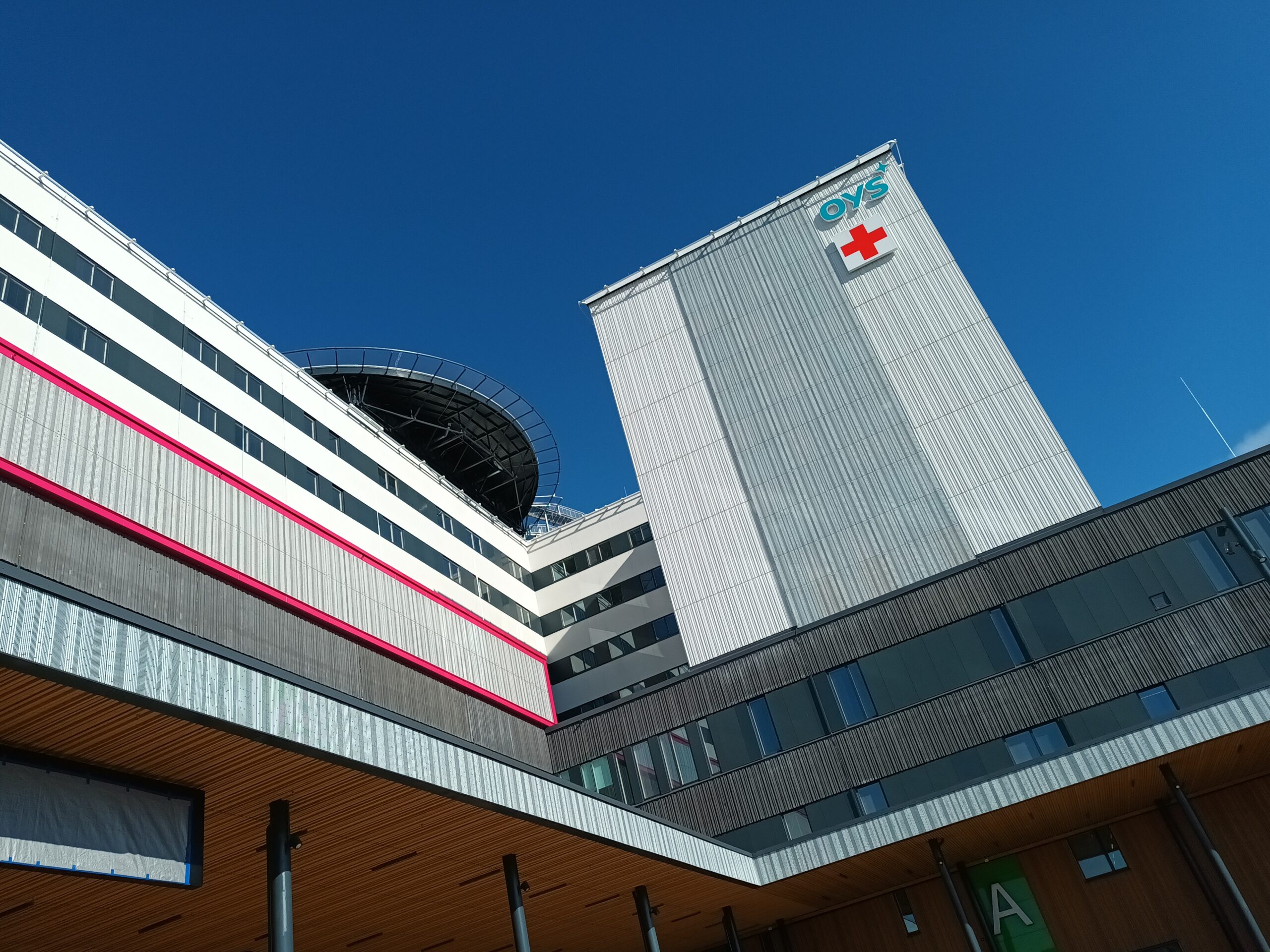
Conference attendees explored cutting-edge facilities, including Future Hospital OYS2030, OYS TestLab and Knoppi, MITTLAB, and Accessible Home (Mahdollistava Koti). The tours also featured the Nokia OTAVA Lab and Oulu University’s Health Tech Research Labs: Multimodal Sensing Lab, UBICOMP Lab, and Human Body Twin Lab, showcasing the latest in health technology and innovation.
During the Nordic Conference on Digital Health and Wireless Solutions, attendees had the unique opportunity to visit the Future Hospital OYS2030, the ”smartest hospital in the world”. This cutting-edge facility showcased advanced medical technologies, including AI, robotic surgery, digital imaging, and telemedicine. Participants learned about the hospital’s commitment to integrating new technologies and sustainability to provide high-quality care. The Future Hospital aims to be fully operational by 2030, setting a new standard in healthcare innovation.
Participants also explored the OYS TestLab and Knoppi, a specialised environment replicating hospital units for product testing, and the MITTLAB for medical imaging research. The Accessible Home demonstrated technology-supported living solutions for individuals with special needs. Nokia’s OTAVA lab highlighted advanced 5G testing capabilities, and the University Health Tech Research Lab presented innovative projects from UBICOMP, MultiModal Sensing Lab, and Human Body Twin Lab. These visits offered comprehensive insights into the future of digital health and technological integration in healthcare.
EU Advances in Digital Health Strategy
Day two of the Nordic Conference on Digital Health and Wireless Solutions began in an atmosphere of anticipation and intellectual curiosity. After an invigorating first day of thought-provoking discussions and innovative presentations, attendees gathered to go deeper still into digital health and its pervasive impact on global healthcare systems. The day unfolded with a series of keynotes, workshops and panel discussions designed to explore the integration of cutting-edge technologies and strategic health initiatives.
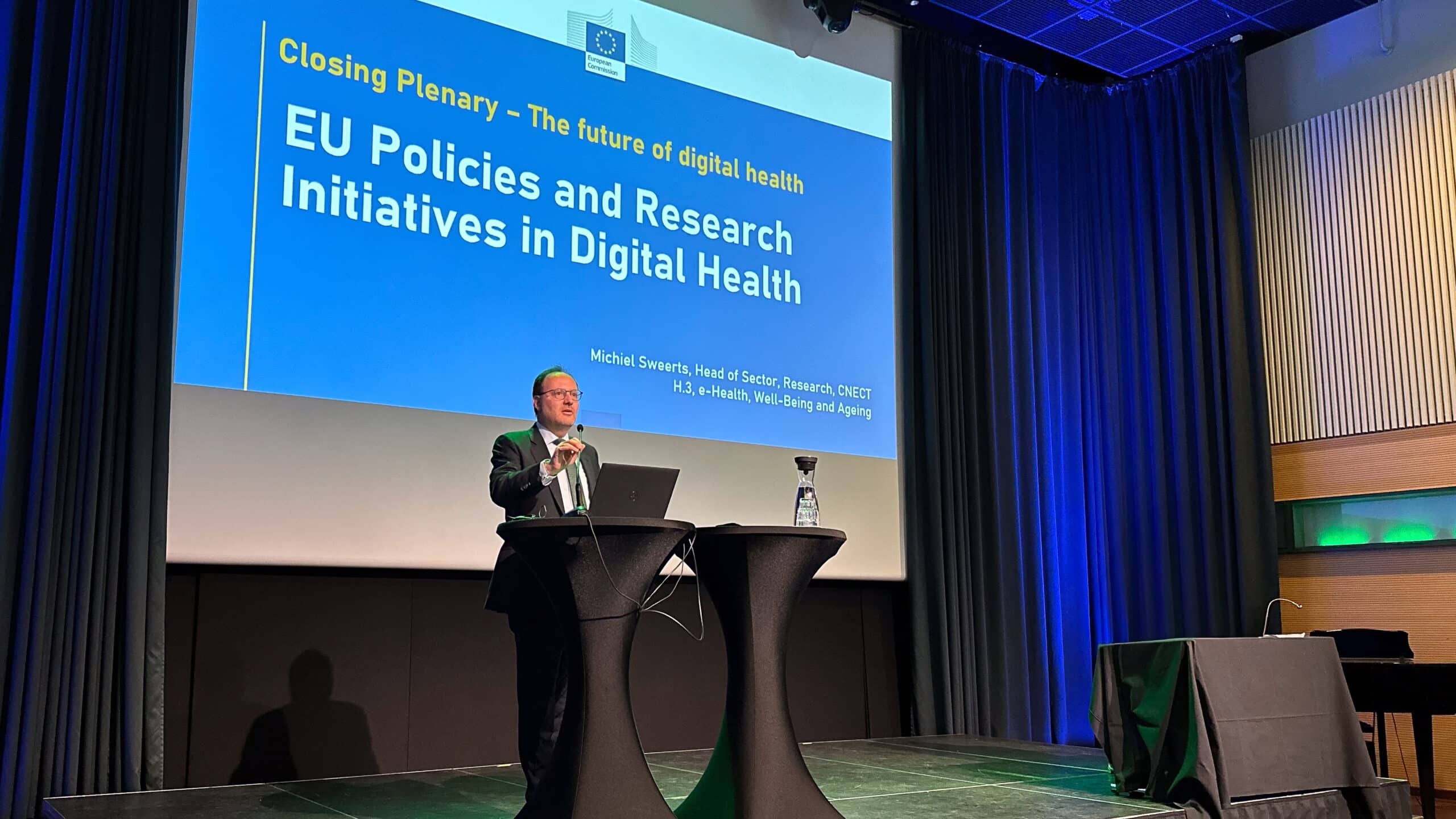
“The health care sector is an integral part of the group’s sectoral agreement to strengthen the cyber-resilience of health care providers and of digital health products and services,” reminded Michiel Sweerts, Head of Research for eHealth, Well-being, and Ageing unit at Directorate-General CNECT.
In his keynote address, Michiel Sweerts, Head of Research for eHealth, Well-being, and Ageing unit at Directorate-General CNECT (Communications, Networks, Content and Technologies) the European Commission, outlined the EU’s strategic approach to digital health, focusing on the transformative legislative and policy frameworks recently adopted to innovate healthcare across the union. He emphasised the ambitious targets the EU has set for the coming years, highlighting the union’s commitment to leveraging digital health to facilitate positive changes across member states.
Sweerts discussed several pivotal pieces of legislation crucial to the EU’s digital health strategy. The Data Governance Act, the Data Act and, notably, the European Health Data Space (EHDS) Regulation are set to redefine how personal health data is accessed and managed across Europe, ensuring seamless cross-border health data management and enhancing care continuity. They establish a secure framework for health data exchange, crucial for integrating and expanding the European market for electronic health records and fostering the development of innovative health technologies. The AI Act will support the safe use of health data in AI-driven tools and systems through a risk-based approach.
Looking ahead, Sweerts emphasised the importance of implementing these regulations effectively to transform healthcare systems across the EU significantly. In particular, one key goal is for every EU citizen to have online access to their electronic health records by 2030, reinforcing the vision of a Digital Decade with electronic health data as a foundational element of healthcare innovation. This holistic strategy meets current technological and regulatory demands and equips the EU’s member states’ healthcare system to address future challenges effectively.
Healthcare Transformation in Northern Finland
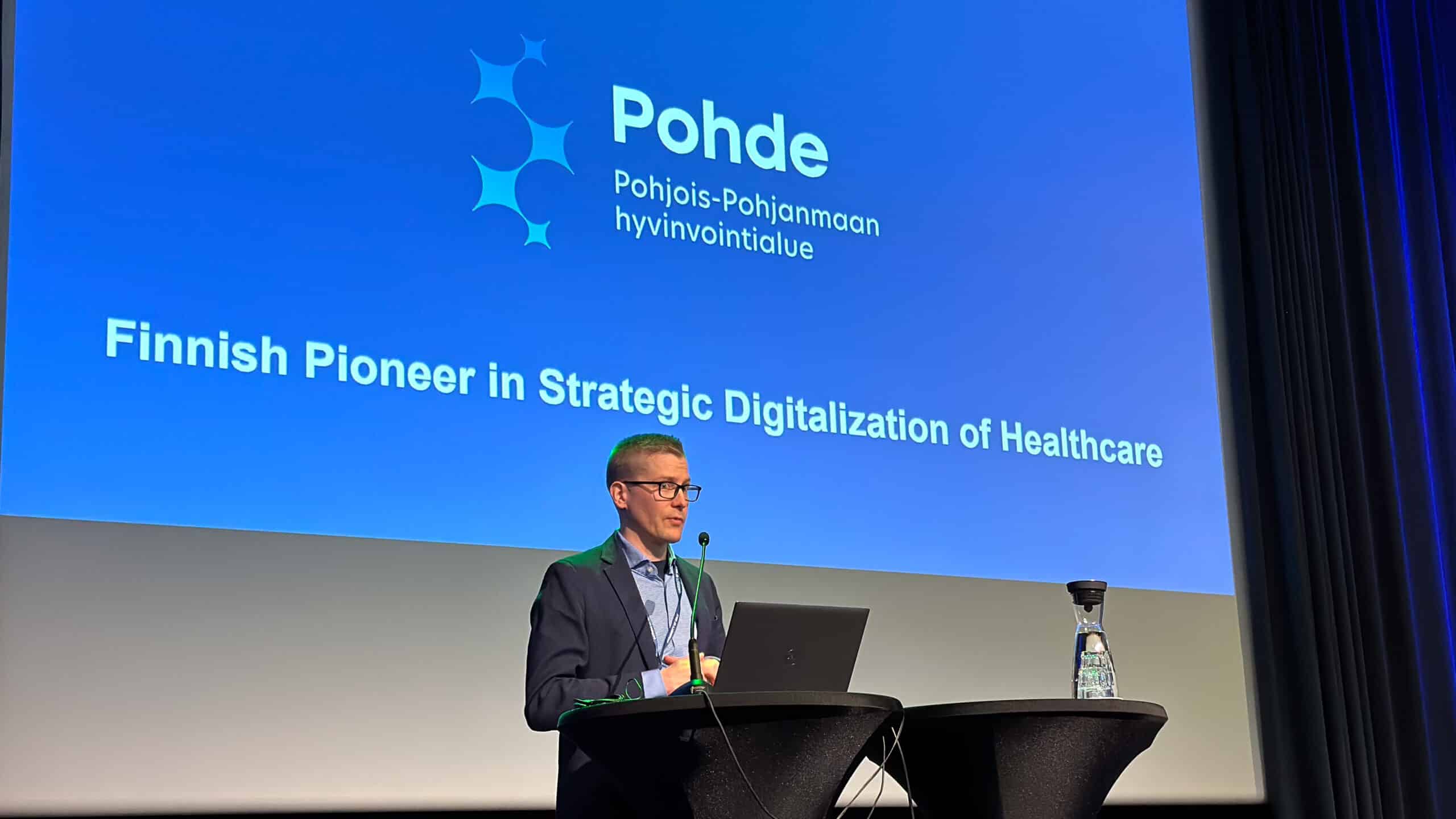
“We must implement advanced digital solutions to deliver healthcare and social welfare services effectively in our vast and sparsely populated regions,” stressed Pasi Eskola, Chief Medical Administrator at the Wellbeing Services County of North Ostrobothnia, Finland.
Pasi Eskola, Chief Medical Administrator at the Wellbeing Services County of North Ostrobothnia, took the stage to discuss the transformative progress being made in the healthcare sector in Northern Finland. Representing both the region and Oulu University Hospital, Eskola highlighted the uniquely Finnish trait of ‘sisu’ (or grit) – a cultural resilience that he believes contributes significantly to the successful implementation of digital health solutions.
He touched on Finland’s exemplary compliance with health regulations, illustrated by high vaccination rates and adherence to COVID-19 protocols. Paradoxically, this Finnish adherence coexists with a cultural penchant for breaking the rules, as whimsically noted in the 2024 Finnish Eurovision Song Contest entry “No rules!” Eskola had his audience laughing.
On the practical aspects of digital healthcare in Finland, Eskola emphasised the strategic use of digital tools to overcome geographical and demographic challenges. He described the development and implementation of the ESKO electronic health record system, a cornerstone of regional healthcare that has been hailed as the best by its users. This system is part of a broader patient-centric approach that includes advanced patient portals, which are actively used by Oulu’s elderly population. With projects underway to extend these digital services to primary care and GP clinics, Eskola’s presentation painted a picture of a region that not only copes with its sparse population and rugged terrain but also uses technology to ensure comprehensive healthcare coverage, demonstrating a proactive approach to both current needs and future healthcare challenges.
Digital Transformation in Primary Healthcare
In a scientific speech, Lena Kan from Johns Hopkins University shared interesting preliminary findings from her study of digital transformation in primary healthcare. She focused, in particular, on how digital health interventions are being used to improve service delivery in primary healthcare. The study, conducted in partnership with the Bill and Melinda Gates Foundation, aims to develop a theory of change that prioritises healthcare outcomes relevant to digital health enablers and interventions.
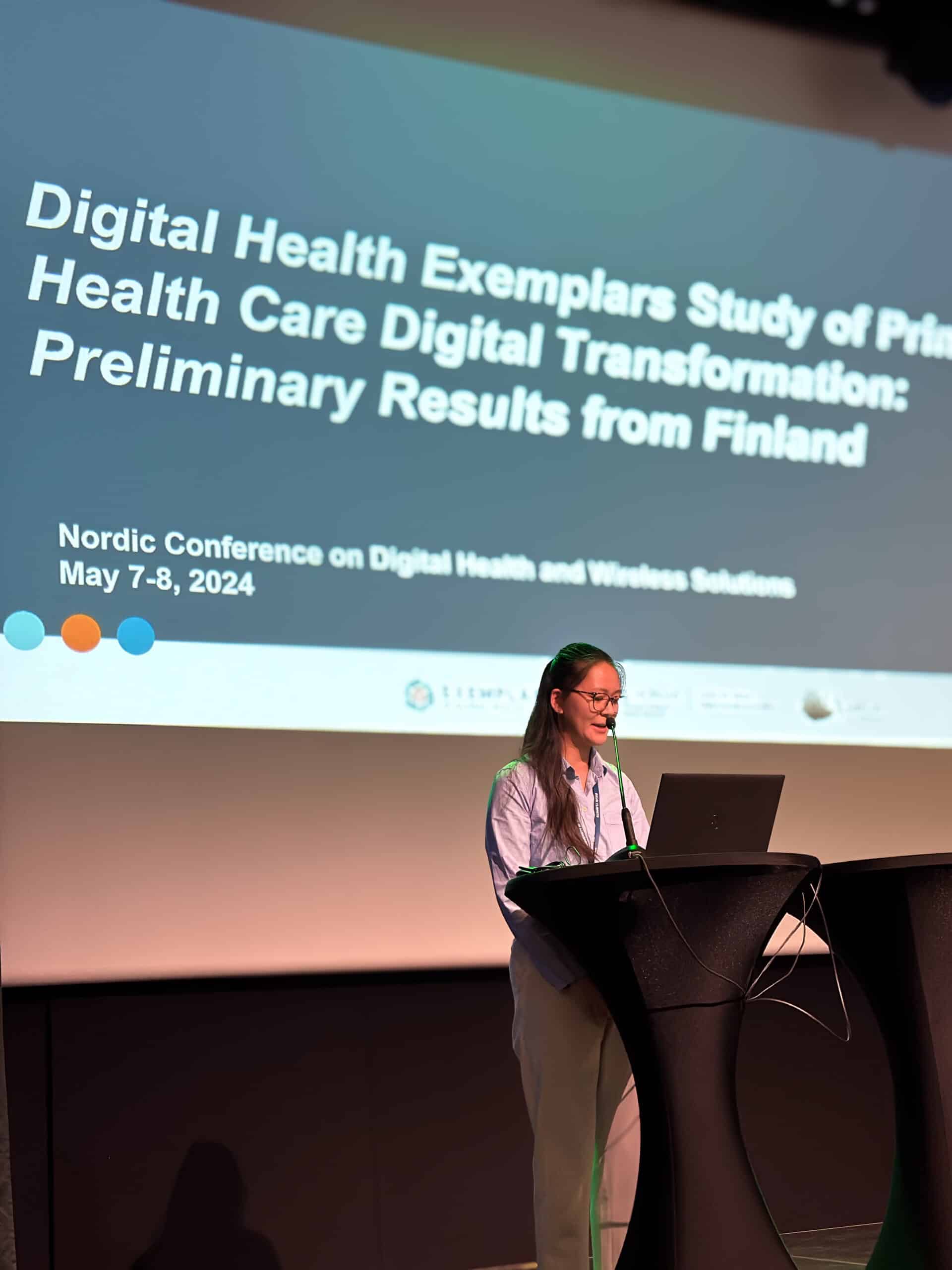
“Finland’s health spending has successfully translated to strong digital health and primary healthcare performance,” shared Lena Kan from Johns Hopkins University from their preliminary findings.
Kan explained the process of selecting Finland as one of the five exemplary countries for the study due to its advanced digital adoption in healthcare and high performance in primary healthcare maturity. The selection was based on a comprehensive set of indicators that mapped countries’ digital health maturity against universal health coverage. She also introduced the Center for Global Digital Health Innovation at Johns Hopkins, which focuses on developing responsive digital health innovations and providing evidence-based support for scaling digital technologies. The centre’s research has highlighted Finland’s leadership in digital health adoption, demonstrating its successful integration of digital health solutions to improve healthcare delivery and patient outcomes. As the research progresses, the Johns Hopkins team will continue to work with Finnish experts to deepen their understanding of the digital health landscape and its integration into primary healthcare.
Academic Contributions and Future Directions
As well as highlighting innovative developments in digital health, the conference showcased the academic rigour and future potential of the field through the presentation of over 100 scientific papers. These papers, which explored various aspects of digital transformation in healthcare, were subsequently published in a two-volume Springer book, the chairing editor of which was Adj. Prof. Mariella Särestöniemi, who was also the chair of the scientific committee in NCDHWS2024. The publication is open access. It reflects the conference’s commitment to broad dissemination of knowledge and fostering a global dialogue on advances in digital health.
The conference recognised outstanding scientific contributions through the Best Paper Awards, which were determined by reviewers’ scores. Zienkiewicz et al. received the Best Full Paper Award for “Influence of Arterial Vessel Diameter and Blood Viscosity on PTT in Pulsatile Flow Model.” Grøndahl Larsen et al. also received the Best Full Paper Award for “Dual-Perspective Modeling of Patient Pathways: A Case Study on Kidney Cancer.” Makkonen et al. received the Best Abstract Award for “Pipeline for Automatic Brain Stimulation with Real-Time Machine-Learning-Based Decoding of EEG Responses.” Additionally, Köyhäjoki et al. received the Best Poster Award for “The Effects of Robotic Training on Walking and Functional Independence of People with Spinal Cord Injury: A Systematic Review, Meta-analysis and Meta-regression.”
Härkönen et al. also received an award for the best poster on “Challenges and Opportunities for Digital Solutions in Cerebrovascular Disease Care” based on audience voting.
In his closing remarks, Professor Reponen expressed his sincere gratitude to the many contributors, including academic colleagues, industry experts, and members of various committees and organisations, who played a pivotal role in the smooth running of the conference. He emphasised the importance of the sessions and networking opportunities provided and urged all participants to take full advantage of these resources. The aim was to foster a collaborative atmosphere that would spur immediate innovation and forge long-term partnerships to drive the field of digital health forward. This strategic focus on collaboration and knowledge sharing will shape the future directions of digital health research and implementation and promises to significantly impact global health outcomes.
Biennial Rendezvous Set for 2026
The Nordic Conference on Digital Health and Wireless Solutions proved to be a resounding success, fostering invaluable discussions and collaborations that propelled the field of digital health forward. Buoyed by the overwhelmingly positive response, the organisers are already making plans to host the next edition of this premier event in 2 years, maintaining the momentum of innovation and knowledge-sharing in this rapidly evolving domain.
